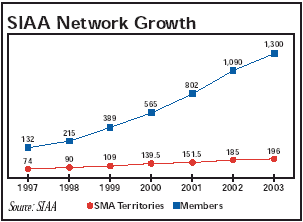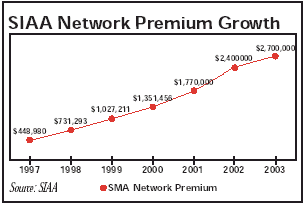At first blush, the Strategic Independent Agents Alliance may look like just one more short-term solution to the increasing shift in the balance of power toward insurance carriers away from independent agents. ommissions get cut, underwriting control is taken away and volume requirements go up. It’s an old story with no lasting solution. Or is it?
SIAA, based in Portsmouth, N.H., is an agency cooperative that, at the very least, allows its member agencies to gain access to markets through the aggregated premium volume which they couldn’t access alone. It now boasts $2.7 billion in aggregated premium volume and more than 1,300 network members in 48 states and Canada.
The group lists as its “strategic partner” companies such as industry heavyweights as The Hartford, Travelers, Zurich, Liberty Mutual and Safeco. Many such vehicles have come and gone, however, usually in the form of cooperative networks or clusters, which SIAA President Jim Masiello says are not built to last.
Partnering, not clustering
“We’re a partnering concept,” Masiello told Insurance Journal. “We just don’t join forces to benefit from whatever clusters benefit from. Clusters implode at some point. … They seem to come into being during a certain time of convenience. As agencies grow and market conditions change that need seems to go away. There are eventually withdrawals and arguments over whose producing what.”
SIAA, on the other hand, excels regardless of market conditions.
“There’s no other organization like ours,” Masiello said. “It’s almost like a hub concept. A cluster is usually very narrowly defined.”
Masiello based the model for SIAA’s network on his Portsmouth-based Satellite Agency Network (now the SAN Group), which he formed in 1983. The SAN Group is now the biggest member of SIAA with independent member agencies and more than $205 million in premium volume.
The basic structure of SIAA is as follows. SIAA, the national group, appoints so-called “master agencies” in various territories around the country. These master agencies then recruit “independent strategic members” (ISMs) to join SIAA. Access to the group’s markets, and more importantly its excess compensation agreements with carriers, is shared across the group as part of the standard 15-year contract.
This is why Masiello and others at SIAA say the group is not built solely for access to companies during a hard market, but for the long haul. By “rolling” compensation from the ISMs up to the SIAA and back down again, agencies can succeed in a soft market when commissions are lower due to more competitive premiums.
“It isn’t just about making a lot of money,” Masiello said. “It’s about enabling people to succeed. People are capable, but they don’t have the resources or the help. We hand those over to smaller agencies and agents coming from direct writers. What it all comes down to is the quality of the individual because we’re very, very relationship driven. We get to know them. They trust us, and we trust them.”
Fifteen-year commitment
Trust would seem to be a prerequisite to making a 15-year commitment as well as to the initial investment required of agencies joining SIAA.
The fee to join “varies by territory,” Masiello said. “We don’t like to put that information out. By joining in the scheme, the investment is not very extensive because it’s a long-term build out. We’re going to show you how to do it.”
SIAA, both at the national level and at the master agency level, also enforces heavy loss control measures to ensure that agencies are not only making a short-term profit, but not endangering the group’s relationships with its partner companies.
Tom Harrison is president of Bayland Insurance Group, a master agency for the Wisconsin territory and doing business as SIA Wisconsin. He said he examined the SIAA concept for more than two years before joining in 2000.
“It seemed too good to be true,” he said. Harrison noted that he was on the verge of taking on a territory for a “true cluster” but decided to sit down with his partner and review the SIAA proposal one more time and decided to join. SIA Wisconsin now has 17 ISMs.
“As opposed to a cluster, we not only bring markets, we actually sit down and partner with these agents. We help them get through the struggles that we did when we were growing our agencies. It’s not just markets, it’s not just excess compensation, it’s mentoring them with regard to everything from management systems, comparative rating systems, marketing and business plans.”
Most ISMs have between one and nine employees.
“We go from A to Z with them,” Harrison said. It’s kind of phenomenal to see the look on their face when they finally get it.”
A way around growing pains
Tim Hyland is president of Hyland, Block & Hyland in Louisville, Ky., and his Agents Helping Agents is the master agency for the Central Kentucky and Southern Indiana territories.
Before joining SIAA in 1997, Hyland had been frustrated by trying to grow his agencies with field producers who cared more about getting a commission in the short term and less about maintaining a good loss ratio.
“They were almost impossible to control,” Hyland said. “We were getting hammered on our loss ratios. It was kind of like herding cats.”
Agents Helping Agents now has 53 ISMs and grossed $80 million in premium volume last year, he added.
“My value as a master agency is I’ve made every mistake you can in building an independent insurance agency, whether it’s hiring, what your commission split should be … I’ve been there.”
Hyland said he was aware of another cluster in town but wasn’t really interested. “They had no real connection except they convinced the company to let their premium aggregate together,” he said. “They didn’t have any grounding. The business being submitted was not really profitable, because they threw all their business in a hat together.
“We have the ability to police that from day one.”
AHA employs a former loss control specialist for The Hartford to monitor the books of business being submitted by the group’s member ISMs.
“The companies understand,” Hyland said. “They wouldn’t have any part of this unless they thought we were working to control the book of business.”
The carrier’s perspective
Bruce Anderson, director of national client practices with The Hartford, has worked with SIAA for the last three years.
“Companies, including The Hartford, have tended to paint these aggregators with the same brush,” Anderson said. “They’re not all created equally. We just concluded a study where we looked at all of our aggregator relationships to look at the ideal profile. SIAA came out to be the closest of any aggregator relationship we have.”
A few of the elements of the SIAA model that sets it apart, according to Anderson, are that “they take very active interest in their membership from ownership standpoint, with minority equity standing; there are high barriers to entry and exit from contractual standpoint; in underwriting, they maintain the access plus facilities which almost act as an MGA, really; and they bring distribution to areas we couldn’t economically reach on our own.”
The shrinking distribution channels for insurance products was a theme hit upon by several people interviewed for this story.
“There are fewer companies and fewer agencies,” AHA’s Hyland said. “This is a nice vehicle to deal with that. It’s a way for companies to keep representatives in areas they will not go in terms of expenses. And it gives small agents the opportunity to be represented by carriers they couldn’t access otherwise.”
Once again, market access is not the be-all and end-all of SIAA. Excess compensation probably is.
“Our member agencies hear about it, but they don’t know how to get it and it’s something they don’t think they could ever get even if they did,” SIA Wisconsin’s Harrison said.
Tapping excess compensation
Once premium is aggregated above a certain point, many carriers offer compensation in excess of commission in order to give agents further incentive to place business with them. By aggregating their premiums, SIAA members have access to that compensation from day one.
“We have one agency that’s at about $2.1 million in premium volume,” Harrison said. “If we roll the book of business for him he has an opportunity to make $81,000 more without selling one more policy.”
It might seem as though the company is paying two or three times for the same premium, but The Hartford’s Anderson explained the policy this way:
“Our approach with them on compensation is to have it reflect their business model. By that, I mean they’re kind of hybrid model of local, regional and national and we seek to build non-redundant compensation that reflects that. So for example we’ll have base competition and incentives at the local level and supplemental incentive for national as an umbrella supporting Hartford. It’s not redundant up and down the different levels. It all kind of hangs together. … They’re compensated for different things.”
Anderson went on to say that, given the changing dynamics of insurance distribution, the SIAA model was one way for large standard carriers to access smaller accounts at a minimum expense.
“The top brokers are kind of operating at a larger account, national account-type level,” Anderson said. “They continue to consolidate but usually with larger shops, $10 million in revenue and above. SIAA plays at a different level, with mom-and-pop type shops we couldn’t access on our own. We do the national stuff, but we also have a very successful small business and personal insurance that’s really the cornerstone of what we do.”
Masiello said SIAA is still growing, and plans to add about 20 territories a year. Whether others will imitate SIAA’s apparent success remains to be seen.
Topics Agencies Claims Excess Surplus
Was this article valuable?
Here are more articles you may enjoy.


 Florida Insurance Agency VP Sentenced to 3 Years in Massive ACA Fraud Scheme
Florida Insurance Agency VP Sentenced to 3 Years in Massive ACA Fraud Scheme  MAPFRE Accuses AAA of Violating Long-Time Exclusive Marketing Agreement
MAPFRE Accuses AAA of Violating Long-Time Exclusive Marketing Agreement  Is the AI Boom a Bubble Waiting to Pop? Here’s What History Says
Is the AI Boom a Bubble Waiting to Pop? Here’s What History Says  Good Times for US P/C Insurers May Not Last; Auto Challenges Ahead
Good Times for US P/C Insurers May Not Last; Auto Challenges Ahead 


